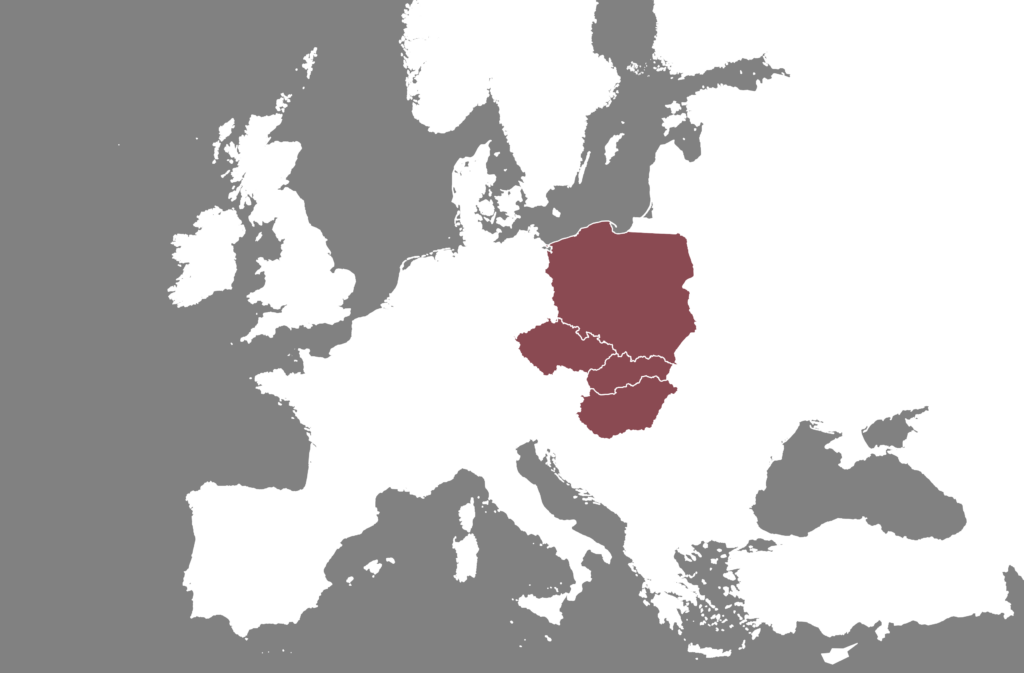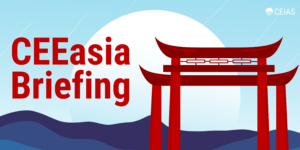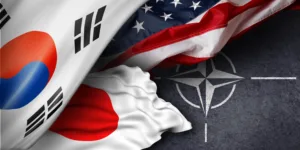Executive summary
-
The Visegrad Four (V4) countries—Czechia, Hungary, Poland, Slovakia—are navigating increased global instability with diverging political responses to shifts in US policy, Russia’s war against Ukraine, and China’s growing international influence. These geopolitical dynamics are reflected in public attitudes towards global affairs and perceptions of the major powers (the US, China, Russia, the EU, and NATO), as captured in a new large-scale public opinion poll conducted by CEIAS in the four countries between late February and early March 2025.
-
Russia is broadly seen negatively across the region, although negative views are less pronounced in Slovakia and Hungary, where pro-Russian sentiment remains common.
-
China is generally perceived unfavorably across the region, despite close political ties with the ruling governments in Slovakia and Hungary. Czech respondents hold the most negative views of China. Compared to CEIAS’s 2020 survey, perceptions of China have remained relatively stable.
-
The EU and NATO continue to enjoy broad public support. Poland stands out for its positive views of NATO, while Czechia has a considerable share of negative views of the EU.
-
Despite the recent strains in transatlantic relations, the US is still viewed more positively than negatively. Polish respondents are the most positive. Slovakia is an exception; it not only harbors predominantly negative views of the US but also stands alone in identifying it as a greater threat than China.
-
Foreign policy views are deeply influenced by domestic political divisions, with supporters of the ruling and opposition parties divided on their views of Russia, China, NATO, and the EU. This suggests that significant foreign policy shifts may occur with each change in government.
-
The US is still regarded as the dominant military power, while China is increasingly recognized for its growing economic strength. Russia’s image as a global power has diminished since 2020. In terms of cultural appeal, the EU remains the most attractive actor, though it lags behind in other domains.
-
While there is some support for greater EU-China cooperation as a way of reducing Europe’s dependency on the US, most V4 respondents prefer strategic alignment with the US and reject Chinese global dominance.
Introduction
The world entered 2025 in a state of geopolitical flux. The return of Donald Trump as US president on January 20 signaled a dramatic departure from traditional US foreign policy, raising alarms across Europe about the possibility of a full American retreat from the continent.
In response, the EU has begun to reassess its long-standing reliance on the US, renewing calls for greater strategic autonomy and independence in global affairs. Meanwhile, Russia’s war on Ukraine grinds on, despite Washington’s attempts to broker a swift resolution.
China has sought to capitalize on the growing transatlantic rift by positioning itself as a reliable partner for the EU. However, Beijing’s ongoing support for Russia’s war effort against Ukraine continues to stoke skepticism in European capitals.
Compounding these geopolitical tensions is the threat of a looming tripartite trade war. Trade frictions between the EU and China remain unresolved, while newly imposed US tariffs on European exports threaten to further strain transatlantic economic ties.
Against this backdrop, some voices in Europe are advocating for closer engagement with China to offset the fallout from strained US relations. European Commission President Ursula von der Leyen hinted at this in her 2025 Davos speech, where she called for less emphasis on values and for more realism in EU foreign policy.
In Central Europe, the Visegrad Four (V4) states—Czechia, Hungary, Poland, Slovakia—are feeling the consequences of this global instability particularly acutely. Located on NATO’s eastern flank, the region faces direct threats posed by Russian aggression and economic vulnerabilities stemming from global trade conflicts, particularly affecting the highly exposed automotive sector.
Despite shared challenges, V4 leaders are responding in divergent ways. Slovak Prime Minister Robert Fico and Hungarian Prime Minister Viktor Orbán have welcomed Trump’s return and his openness to negotiations with Russia, leveraging this shift to justify their own illiberal policies and their stance towards Moscow. In contrast, Czechia and Poland, despite being transatlantic stalwarts, have been relatively critical of Trump’s foreign policy and reaffirmed their commitment to the EU, Ukraine, and European defense. However, these positions are politically contested and could change, particularly after Czechia’s upcoming general election in October 2025.
The tremors in international politics are also affecting popular sentiment across the V4. Drawing on a large-scale public opinion survey conducted by CEIAS in early 2025, this report provides a snapshot of popular attitudes in the V4 countries towards China, the EU, NATO, Russia, and the US. It examines overall public sentiment, perceived levels of power and threat, and foreign policy preferences. It also dissects how these views diverge along political lines, offering detailed insights into the perspectives of supporters of different parties in each country. Special attention is given to the dynamics of US-China relations and how they are perceived by the Central European public.
The survey was conducted in the immediate aftermath of US Vice President JD Vance’s speech at the Munich Security Conference, which ignited a rapid EU response calling for more strategic autonomy. Thus, this report offers a timely reflection on how shifting US policies are resonating in Central Europe. However, it is worth noting that these turbulent developments may take some time to fully manifest in the broader public perceptions.
About the public opinion survey
The anonymous survey was conducted online between 14 February and 9 March 2025 in Czechia, Hungary, Poland and Slovakia. The sample sizes were: 1509 respondents in Czechia, 1505 respondents in Hungary, 1508 respondents in Poland, and 1507 respondents in Slovakia. The sample is representative of gender, age (adults between 18-65), education, settlement size, region, and ethnicity (only in Slovakia).
The survey was conducted in partnership with NMS Market Research under the project “Investigating China-related narratives in the Central European information space,” implemented by CEIAS in cooperation with the Matej Bel University, and supported by the European Media and Information Fund (EMIF).
For the purpose of easier comprehension, in-text data references are rounded to full numbers.
Central Europeans’ attitudes towards major powers
The V4 countries exhibit notable differences in their perceptions of the key global actors. While Russia is viewed most negatively by the respondents across all four countries, the proportion of respondents with a favorable opinion of Russia varies widely—from just 6% in Poland to 29% in Slovakia. Notably, Slovakia is the only V4 country where negative perceptions of the United States are more prevalent than positive ones.
China is generally viewed unfavorably throughout the region, with Czechia registering the highest proportion of negative views—59% of respondents express an unfavorable opinion of the Asian power. Despite Hungary’s close political ties with Beijing under the Orbán government, negative perceptions of China also dominate there. This is not a new development; a similar pattern was observed in CEIAS’s 2020 survey. However, since then, support for China has grown more positive among backers of Hungary’s ruling Fidesz party.
NATO continues to be seen positively across all four countries, with particularly strong support in Poland. The EU also enjoys broad approval in most of the region, but Czechia stands out for its relatively high share of Euroskeptic sentiment—nearly 40% of respondents hold a negative view of the European Union.
When compared to CEIAS’s 2020 poll, which used the same set of questions, notable shifts can be observed in public perceptions of the US, Russia, and China. The most significant change is the sharp decline in favorable views of Russia across all four countries, particularly in the wake of its full-scale invasion of Ukraine. Slovakia saw the most dramatic drop, with positive views of Russia falling by 18 percentage points—the largest decrease among the V4 nations.
China’s image, by contrast, has seen a modest improvement in three of the four countries, with the exception of Poland, where positive perceptions have slightly declined.
The US remains the most positively perceived outside power. Since 2020, favorable views of the US have increased in Czechia and Slovakia, while only minor declines have been recorded in Hungary and Poland. This suggests that recent shifts in US foreign policy toward Europe have not yet significantly undermined Central European perceptions of the US—though it may still be too early to draw definitive conclusions.
A more granular picture emerges when factoring in respondents’ voting preferences. In Czechia, supporters of Stačilo! (Enough!)—a coalition of several anti-establishment parties led by the Communist Party of Bohemia and Moravia—were the only group to view China more positively than negatively. They also held the most favorable views of Russia among all Czech political party electorates.
In Poland, supporters of none of the major political parties expressed more positive than negative views of either Russia or China.
Supporters of Hungary’s ruling Fidesz-Christian Democratic People’s Party (KDNP) coalition and of Slovakia’s governing parties, SMER-SD and HLAS-SD, showed significantly more favorable attitudes toward China. Across the whole of the V4, supporters of Slovakia’s HLAS-SD held the highest share of positive views (49%) of China. However, important differences emerged even between SMER-SD and its coalition partner HLAS-SD: SMER-SD supporters were notably more negative toward the EU and more positive toward Russia. Indeed, 67% of SMER-SD supporters viewed Russia positively—the highest such figure among all major parties in the V4 region.
Sharp divides between governing and opposition camps were also evident across the region. In Czechia, supporters of the governing coalition and those of the two main opposition parties, ANO and Freedom and Direct Democracy party (SPD, differed significantly in their views of NATO and the EU. Opposition supporters tended to hold more negative opinions of both institutions. Although ANO and SPD supporters were also somewhat more favorable toward China than government supporters—30% and 32%, respectively—negative views still prevailed (52% and 37%).
In Hungary and Slovakia, the supporters of the main opposition parties—Tisza and Progressive Slovakia (Progresívne Slovensko)—held starkly different views of key international actors than supporters of the governing parties. Supporters of both opposition groups expressed markedly more positive attitudes toward the EU and NATO, while holding more negative views of Russia—and, to a lesser extent, China. The divide was especially pronounced in attitudes toward the EU: 78% of Tisza supporters had a favorable opinion of the EU, compared to just 32% among Fidesz-KDNP supporters. In Slovakia, the gap was even wider, with 87% of Progressive Slovakia supporters expressing a positive view of the EU, in contrast to just 22% of SMER-SD supporters who viewed the bloc positively (63% of SMER-SD supporters had negative views of the EU).
A similar political polarization over the EU is evident in Poland. While 86% of governing Civic Coalition supporters held a positive view of the EU, this dropped to 42% among supporters of the opposition Law and Justice party (PiS). Actually, a majority (48%) of PiS supporters expressed a negative opinion of the bloc.
Power and threat perceptions
From an international relations perspective, it is essential to analyze how the major powers are perceived in terms of their distinct sources of power: military power, economic power, and soft power.
Unsurprisingly, the US continues to be seen as the most militarily powerful among the major powers, with approximately 90% of respondents across the V4 recognizing its dominance in this domain. As of 2025, China is generally viewed as the second most militarily powerful major power, marking a significant shift from 2020, when Russia held that position.
This change points to a notable decline in perception of Russia’s military power in Central Europe, likely due to its altering performance in the ongoing war against Ukraine. This decline is most evident in Poland–while in 2020, over 80% of Poles thought Russia to be militarily strong, in 2025, the share shrunk to 61%. Still, the EU remains to be seen as the militarily weakest of the four powers.
In terms of economic power, China and the US are perceived as equally strong by the Czechs and Hungarians. In Poland, the US is seen as slightly more economically strong than China. Only in Slovakia is China considered more economically powerful than the US. Slovaks and Hungarians tend to see Russia as more economically powerful than the EU, whereas Poles and Czechs think the reverse (though by a slim margin in the Czech case).
Among the three key dimensions of global influence—economic power, military strength, and cultural appeal—the EU stands out only in cultural attractiveness. Between 60% and 65% of Central Europeans find the EU to be culturally attractive. In Czechia, Poland, and Hungary, the US is seen as the second most culturally attractive actor. In Slovakia, the US is seen as the least culturally attractive of the global powers—thus, Slovaks see China and Russia as more culturally attractive than the US. In the rest of the region, China trails behind the US in terms of cultural appeal, and Russia is the least attractive of the four powers.
When it comes to preferred foreign policy alignment, the EU remains the top choice across the V4 countries, closely followed by the US. In Poland, the EU and US are equally desirable. Support for aligning with Russia or China remains low, even in countries where public perceptions of these powers are more favorable.
Russia is viewed as the region’s top threat, though the intensity of this perception varies. Some 84% of Poles and 76% of Czechs think it to be the biggest threat, compared to 57% of Slovaks and 55% of Hungarians. China is generally viewed as the second-biggest threat. This feeling is the most prevalent in Czechia (52%). In Slovakia, the US (42%) is notably seen as more threatening than China (38%).
US-China competition through a Visegrad lens
As the EU faces mounting pressure from both the US and China—across economic, technological, security, and increasingly normative dimensions—the question of how to position itself between these two powers becomes ever more pressing. Central Europeans’ views of this dilemma reveal a high degree of complexity.
When asked whether the EU should strengthen cooperation with China to reduce its dependence on the US, roughly one-quarter to one-third of respondents across the V4 countries expressed support for this move. However, the responses vary significantly among the four nations, once again reflecting a north-south divide within the region. In Slovakia, some 39% agreed with the statement, followed closely by Hungary at 36%. Only 19% of Slovaks and 24% of Hungarians disagreed with closer alignment with China. By comparison, 35% of Czechs and 30% of Poles disagreed with this notion, slightly higher than the percentages who supported it—27% and 28%, respectively.
Despite this notable openness to EU-China cooperation, few Central Europeans would actually prefer a world dominated by China over one led by the US. Only 11% of Czechs, 13% of Hungarians, 11% of Poles, and 19% of Slovaks believe a Chinese-led global order would be better for their country than continued US hegemony.
This preference becomes even clearer when the binary choice is made explicit, such as when respondents were asked, “Should the EU choose one partner between the US and China, who should it choose to align with?” In Czechia and Poland, this preference is the most profound, with 60% and 68% of respondents (respectively) indicating this option. Even though the Hungarian government has been closely aligning with Beijing over the past decade, only 17% of Hungarians would prefer a partnership with China over the US, and 53% indicated a preference for the US. Slovakia stands out as the most divided, with 45% of respondents preferring a partnership with the US over China (the more popular choice) and 29% favoring China over the US.
This report is published within the project “Investigating China-related narratives in the Central European information space” that CEIAS is implementing in cooperation with Matej Bel University, supported by the European Media and Information Fund (EMIF) managed by the Calouste Gulbenkian Foundation.
The sole responsibility for any content supported by the European Media and Information Fund lies with the authors, and it may not necessarily reflect the positions of the EMIF and the Fund Partners, the Calouste Gulbenkian Foundation, and the European University Institute.
The survey was conducted in partnership with NMS Market Research.









